It’s widely acknowledged that software design significantly influences its perceived credibility. Users prefer solutions that present themselves with polished, professional, and swift-loading web pages.
These characteristics hold significant weight for blockchain ventures endeavoring to cultivate trust within the broader audience. Considering the inherently complex nature of blockchain technology, the success of your cryptocurrency project hinges greatly on offering a user experience (UX) and user interface (UI) that prioritizes customer needs.
Having amassed considerable experience as a reputable crypto web design agency, we’ve crafted many exceptional cryptocurrency software design solutions. Prepared by our skilled specialists, this article aims to elucidate the best practices in blockchain software design.
The importance of design in blockchain solutions
Cryptocurrency software refers to the suite of digital tools and protocols that enable the creation, management, and transfer of digital currencies. It encompasses various components like wallets, mining software, and exchange platforms, facilitating transactions and ensuring the integrity of the decentralized ledger system.
Blockchain, on the other hand, serves as the underlying technology powering cryptocurrencies. It’s a distributed and immutable network. It records all transactions across different computers, ensuring transparency, security, and decentralization.
It’s crucial to acknowledge that blockchain technology still lacks user-friendliness. For instance, many individuals find it challenging to purchase cryptocurrencies for the first time. This is why it is so essential to apply the best practices of blockchain UI UX to create a smooth and clear cryptocurrency software design that will attract users. You should ensure a simple and convenient user journey to stay competitive with your solution.
Let’s see how UX and UI differ to understand better the design principles and best practices we will mention below.
| User experience | User interface | |
|---|---|---|
| Definition | The overall functionality and purpose of the software or tool | The structure and layout of elements that users interact with to accomplish tasks |
| Focus | The full experience, from the user’s first contact to the last | Visual touchpoints that enable users to interact with the solution |
| Purpose | Creating structural solutions for pain points that users face anywhere along their journey with the solution | Combinations of typography, colors, buttons, animations, images |
| Results | Products that satisfied users with their effectiveness | Projects that delight people aesthetically |
Core principles of exceptional crypto UX
Let’s explore the core principles behind designing outstanding crypto user experiences.
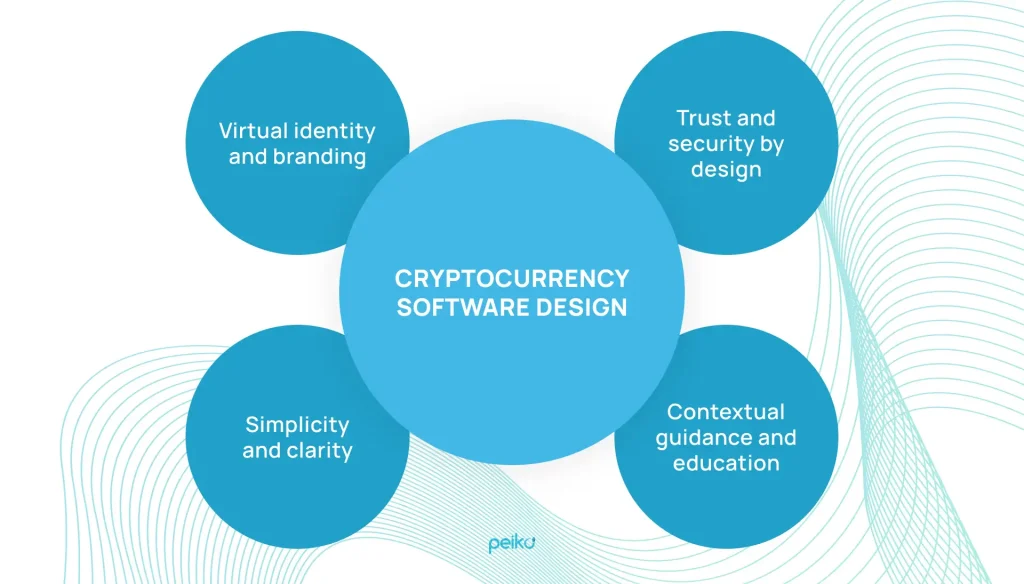
Simplicity and clarity
Blockchain technology, with its decentralized architectures and cryptographic underpinnings, inherently embodies complexity. Effective UX design illuminates pathways through this complexity for end-users. It ensures that even those less versed in technical intricacies can seamlessly interact with blockchain solutions.
For newcomers to the Web3 field, wallets are often their initial encounter. Hence, it’s crucial to design a crypto wallet with beginner-friendly interfaces. Solving the complexity of wallet addresses is equally vital, as they often pose a hurdle with their alphanumeric format.
A notable example is MetaMask, a widely-used wallet, which simplifies the process by enabling users to copy their wallet address with a single tap from the home screen. So, users don’t need to memorize or write down their wallet addresses.
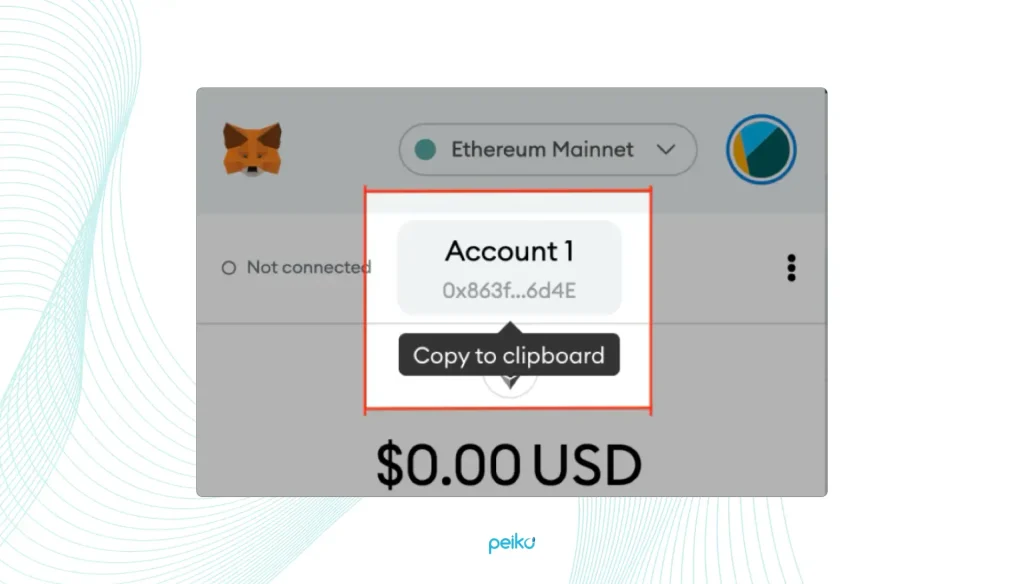
Trust and security by design
User trust is the key to the widespread adoption of blockchain solutions. Intuitively crafted interfaces instill confidence, assuring users of the security of their transactions and the safeguarding of their data. By prioritizing blockchain UI UX design, Web3 solutions can nurture trust, fostering a greater embrace of the technology.
The near-instantaneous speeds of Web2 have heightened our expectations for swift interactions, rendering delays frustrating for users. Incorporating links for users to track their transactions on blockchain explorers like EtherScan or BSCscan can offer transparency, alleviating concerns about transaction progress.
Uniswap exemplifies this approach effectively. The decentralized exchange enables users to monitor their transaction status post-swap and encourages them to verify progress on platforms like Etherscan.
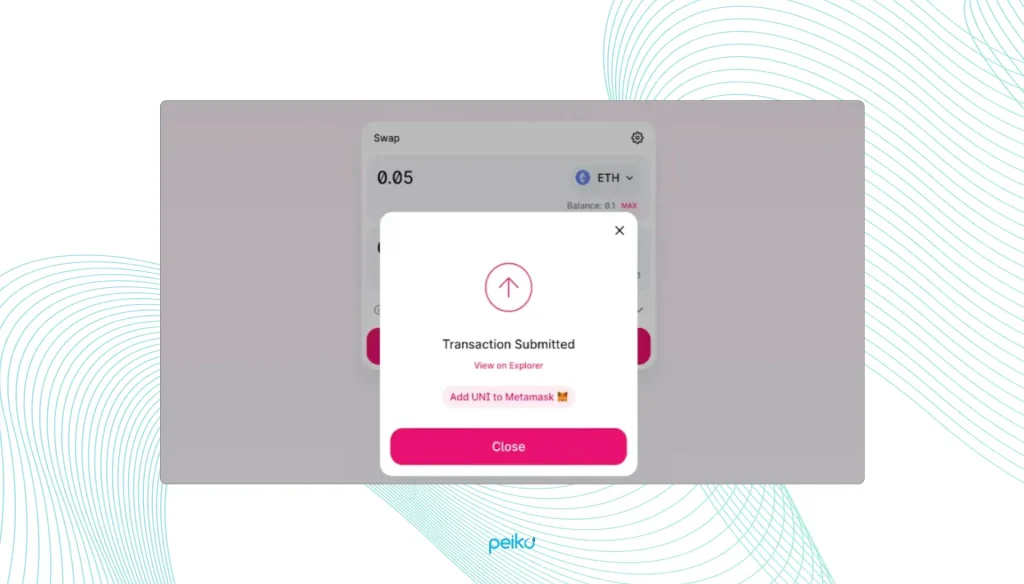
Virtual identity and branding
A strong visual identity and consistent branding are essential components of an outstanding crypto web design. Well-designed visuals not only make a platform more attractive but also create an impression of credibility and professionalism, which is vital in the cryptocurrency market.
Cohesive branding elements such as color schemes, typography, and logos help users quickly familiarize themselves with the platform, enhancing their confidence. These visual cues should reflect the platform’s core values—whether that’s reliability, innovation, or simplicity—while also ensuring accessibility for all users, including those with visual impairments or specific preferences.
Contextual guidance and education
Providing users with contextual guidance and educational resources is vital for a positive user experience. Crypto concepts and tools can often be overwhelming. So, platforms should ensure that users never feel lost or confused. This can be achieved by offering in-app tutorials, informative tooltips, and easily accessible educational materials.
Clear explanations of complex terms and processes, along with interactive guides and FAQs, can help users—especially beginners—navigate the platform with confidence. By offering support within the app and empowering users to make well-informed decisions, platforms can foster both trust and engagement, ultimately contributing to a more satisfying experience.
The Peiko team is ready to help.

Designing for inclusivity and accessibility
Let’s consider how to create a blockchain solution, making it more user-friendly and welcoming to a diverse audience.
Reaching a global audience
To maximize user adoption, blockchain platforms must be designed with a global audience in mind. This involves accommodating various languages, currencies, and payment methods to guarantee the platform’s global accessibility.
Platforms should also consider regional regulations and cultural differences, adapting the UX to cater to the specific preferences of various user groups. By providing localized content and customizing the interface to accommodate diverse global standards, blockchain platforms can offer a more inclusive and appealing experience, attracting users from various corners of the world.
Meeting accessibility standards
Following standards like WCAG (Web Content Accessibility Guidelines) ensures that users with disabilities, including those with visual or hearing impairments, can use the platform efficiently.
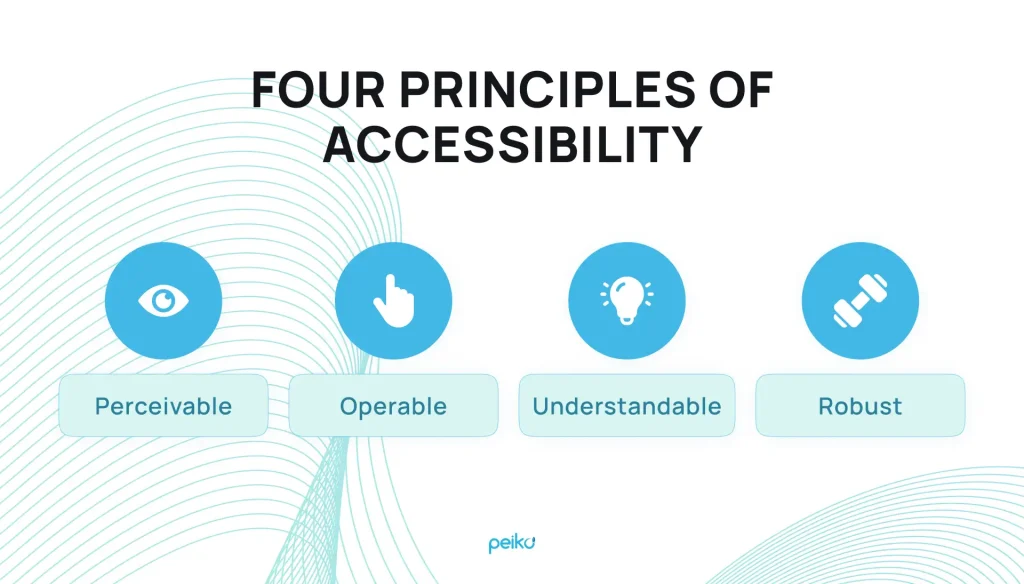
Improving onboarding and conversion flows
A seamless onboarding experience is essential for driving user retention and boosting conversion rates on blockchain platforms. Simplifying the registration process and offering clear, easy-to-follow guidance can make it easier for new users to get started.
Interactive walkthroughs, tooltips, and visual prompts can help users through essential tasks, such as wallet creation or completing their first transaction. Reducing barriers, such as lengthy KYC (Know Your Customer) processes or slow transaction times, can further streamline the user experience. Platforms can foster better user engagement and satisfaction by optimizing onboarding and conversion flows.
Leveraging emerging technologies
Emerging technologies present exciting opportunities to elevate the blockchain user experience. For example, artificial intelligence (AI) and machine learning (ML) can be harnessed to offer users personalized experiences, such as tailored recommendations or predictive analytics for investment decisions. Blockchain platforms can integrate biometric technologies like facial recognition or fingerprint scanning to offer both secure and user-friendly login options.
Additionally, augmented reality (AR) and virtual reality (VR) could transform user interactions with decentralized applications, creating more immersive and intuitive experiences. By embracing these cutting-edge technologies, platforms can stay ahead of user expectations and offer innovative solutions that push the boundaries of crypto web design.
Examples of intersecting UI/UX design and blockchain
The burgeoning world of blockchain technology presents a unique challenge and opportunity for UI/UX designers. In this section, we explore captivating examples of how blockchain and user-centered design converge to create innovative and secure user experiences:
Transparent transaction records
Issue: Conventional financial systems often lack transparency, leaving users uninformed about their transaction statuses and details.
Resolution: Blockchain UX UI designers have the opportunity to craft intuitive dashboards showcasing comprehensive transaction records. Leveraging blockchain’s decentralized nature, users can track each transaction, guaranteeing a transparent and easily accessible log of their financial engagements. This fosters trust by granting users insight into the complete transaction lifecycle.
Protected crypto wallets
Issue: Concerns over security plague cryptocurrency wallets, with risks of unauthorized access and fraudulent activities.
Resolution: Blockchain UX UI designers can integrate multi-layered authentication processes and visually highlight the wallet’s security features. Intuitive cryptocurrency software design aids users in establishing robust passwords, activating two-factor authentication, and comprehending encryption measures. Clear visual indicators reassure users of the safeguarding of their digital assets.
Simplified key management
Issue: Non-technical users find cryptographic key management daunting and complex.
Resolution: Designers can streamline key management through well-crafted interfaces. Implementing secure key recovery options, offering straightforward guides on key backup procedures, and incorporating biometric authentication enhance security. A user-centric approach to key management ensures users retain asset control without compromising security.
We have mentioned just a few cases of issues with blockchain technology and how a blockchain UI UX designer can help solve them.
Case studies and successful examples
Upon a cursory examination of numerous crypto web solutions, it becomes evident that usability isn’t always guaranteed. Many crypto projects overlook UX and UI, placing their trust in software engineers rather than in a blockchain UI UX designer. They hope that users will navigate the platforms independently.
However, not all crypto web projects are created equal. We’ve handpicked a selection of standout examples renowned for their user-friendliness, serving as sources of inspiration for your endeavors:
Coinbase
It is an online platform that facilitates cryptocurrency transactions and boasts a clean and organized UI characterized by a concise color palette and ample negative space. Its large typography and adherence to UX writing best practices contribute to a professional and visually pleasing interface.
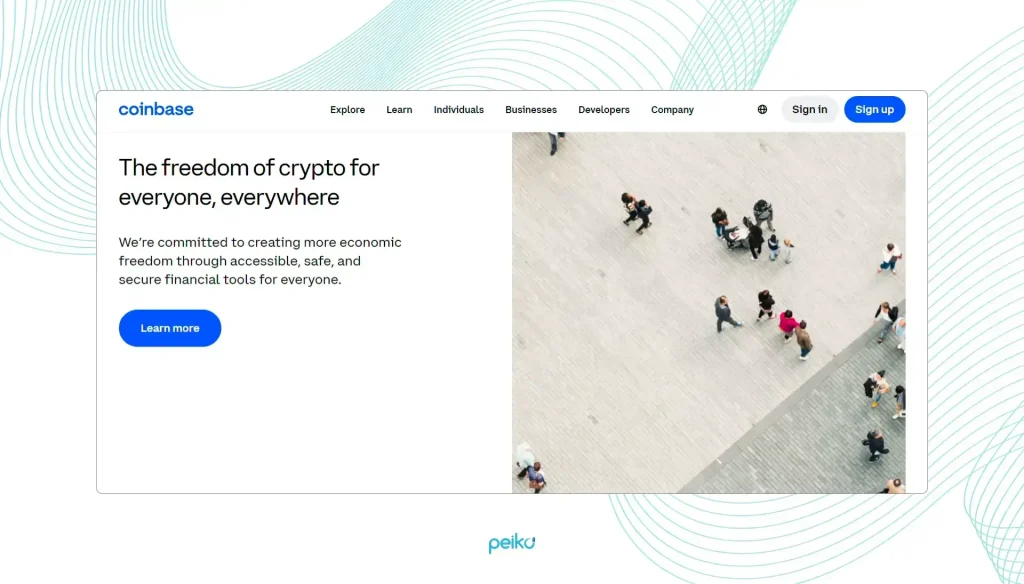
Kraken
This well-established cryptocurrency exchange platform shares similarities with Coinbase in terms of UI, featuring a light color scheme and intuitive navigation. Its user-friendly approach caters to both novices and experienced traders, offering a range of features from futures trading to over-the-counter (OTC) desks.
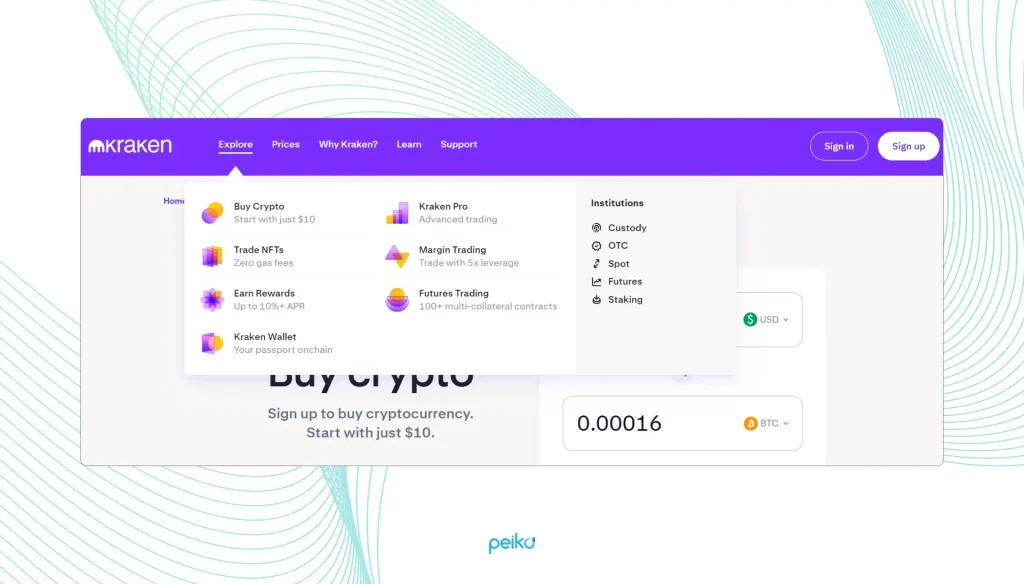
MetaMask
A popular cryptocurrency hot wallet that stands out for its clean and uncluttered UI, complemented by a toggle for light and dark modes. The platform’s intuitive navigation and straightforward setup process make it accessible to users of all levels, while its support for a variety of cryptocurrencies enhances its appeal.
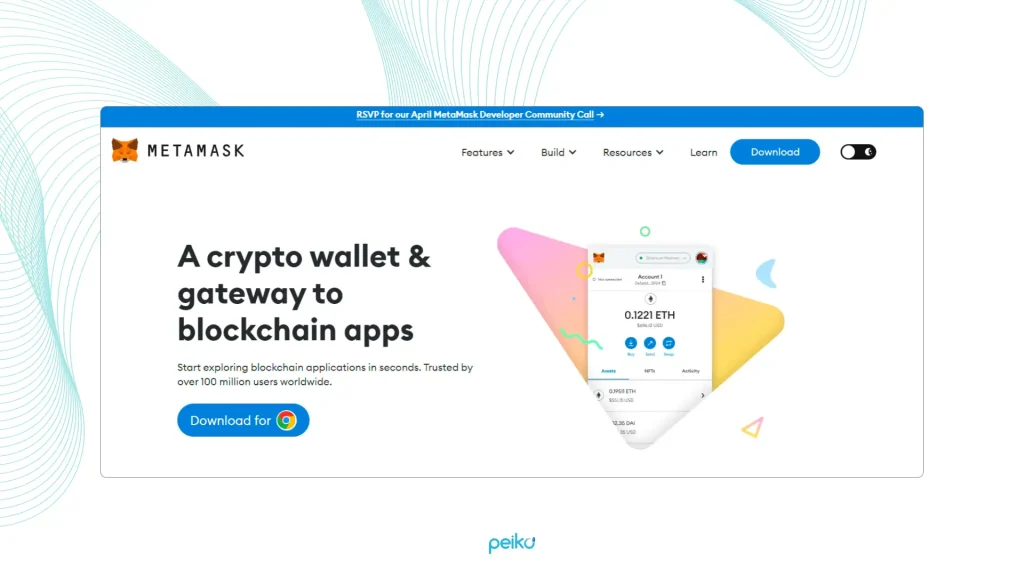
OpenSea
As the leading NFT (non-fungible token) marketplace, OpenSea boasts a visually engaging UI with dynamic color schemes and motion graphics showcasing popular NFT collections. Its user-friendly features enable seamless minting, buying, and selling of non-fungible tokens, catering to both creators and collectors.
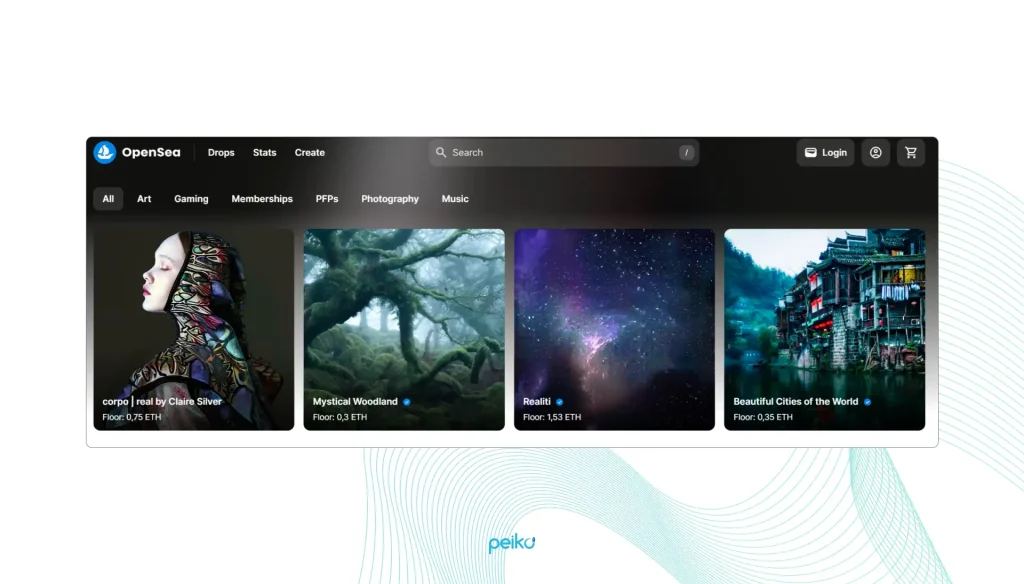
In addition to advanced functionalities, these websites prioritize conversion-driven crypto design principles, setting them apart in the competitive crypto landscape. Let’s delve into how you can achieve similar success with your designs.
Crucial aspects of top UI crypto solution design
How to build Telegram Mini Apps that will engage users? How to create a user-friendly NFT marketplace? The right UI design is a vital component of the development of successful blockchain projects.
An effective website crypto design not only conveys professionalism but also fosters trust among new visitors. It should integrate helpful features that enhance user experience while considering elements such as color choice, typography, calls to action, website features, and contact information.
Color palette
Color selection is crucial in design, and crypto design is no different. As a general guideline, limit your color palette to three hues: a primary color and two secondary colors to highlight key information. We suggest deriving your palette, especially the primary color, from your logo’s colors. If that’s not feasible, consider your specific use case.
For example, if you’re developing a wallet for novice crypto users, opt for a color scheme akin to popular online banking platforms – familiarity breeds trust and security. Additionally, leverage the versatility of light and dark themes.
Many prominent crypto platforms offer users the option to switch between modes. Typically, a dark theme complements graphics-rich platforms, such as NFT marketplaces. Conversely, a light theme may be more suitable if your solution predominantly features text and targets crypto beginners or older demographics.
The color palette sets the tone and conveys the brand’s message, which is vital in establishing brand identity. Dark hues evoke a sleek and modern feel, while white backgrounds exude cleanliness and professionalism. You can also balance cool and warm colors to ensure a harmonious color scheme that resonates with visitors.
Typography
By encompassing text size, style, spacing, and font, typography significantly impacts readability and contributes to the brand’s tone. Implementing appropriate white space and font sizes enhances readability, with 11-point font sizes being optimal. Selecting between sans serif and serif fonts depends on the desired tone and elegance of the brand.
Clear calls to action
They guide visitors to take the next step, whether it’s creating an account, downloading an app, or learning more. Clear and concise calls to action strategically placed throughout the website improve effectiveness and encourage conversions. Variations in calls to action, such as learning more about the brand or signing up for a crypto app, cater to diverse visitor needs.
Website features
Including essential statistics, crypto exchange prices, and helpful tools enriches the user experience and provides value to visitors. Live updating cryptocurrency market statistics and animated statistics capture attention and engage visitors, while reviews and endorsements instill confidence and credibility in the brand.
Contact information
Providing contact information is crucial for facilitating communication between visitors and the brand. Contact forms on every page and a dedicated contact page offer convenient channels for visitors to voice opinions and ask questions. Displaying official contact information prominently, such as in the footer of the website, enhances accessibility and encourages engagement.
Incorporating these elements into crypto website design not only enhances aesthetics but also cultivates trust and encourages meaningful interactions with visitors.
Our speailists will help you.

The Peiko team knows how to design intricate systems like blockchain
Turn to our team, and we will implement all your blockchain business ideas in life with outstanding UX and UI design. We’ve outlined four guiding principles crucial for our organization’s crypto website design:
1. Transparency
Transitioning from traditional systems to blockchain can unsettle users, particularly with substantial assets involved. Users need visibility into blockchain’s inner workings to foster trust. Thus, we prioritize illustrating how blockchain enhances processes, such as showcasing data visibility and audit trails.
How we use this principle:
- Add interactive timelines demonstrating entity transformations;
- Provide summarized blockchain insights;
- Create interactive dashboards offering comprehensive views of processes and assets.
2. Uniformity via design systems
Given the diverse entities within supply chains, maintaining visual consistency is paramount. Our meticulous visual design system ensures coherence, simplifying user tasks without overwhelming them. A harmonized blockchain UX UI design fosters user comfort, easing adoption, crucial for novel technologies like blockchain.
Our application:
- Apply UI kit in Figma with the latest features for a unified crypto website design system that helps us to work more efficiently;
- Use visual coding to denote entities and statuses;
- Utilize reusable interaction models for core functions.
3. Effective communication
Blockchain applications may differ significantly from conventional tech solutions. We cater to a diverse user base, from crypto experts to those with basic understanding.
How we leverage this principle:
- Embrace a global user perspective throughout the blockchain design process;
- Craft clear user personas considering their expertise and engagement levels;
- Prioritize efficiency in action execution for users.
4. Upholding trust
Handling sensitive data demands unwavering user trust. Our applications prioritize reliability, trustworthiness, and stability through transparent data exposure, consistent feedback, and proactive guidance. This instills user confidence in every interaction.
Examples of how we apply this principle:
- Provide clear feedback to users, especially in financial trading apps;
- Integrate onboarding seamlessly into blockchain products;
- Maintain a robust, up-to-date security model that is communicated across the team.
As the Peiko team provides top blockchain development services and creates solutions that engage users, our team diligently strives to leave a lasting impression. We use top-notch UI and UX research blockchain practices to build a seamless and captivating user journey from inception to completion.
The Peiko team has vast experience creating modern and user-friendly blockchain solutions. We are proud to present one of our design-focused case studies for the crypto wallet project. It is a cutting-edge, non-custodial multi-currency cryptocurrency wallet supporting both EVM (Ethereum Virtual Machine) and non-EVM networks.
The wallet incorporated seamless cross-chain swap functionality, enabling users to manage their assets effortlessly. Our team also focused on refining the blockchain UX UI design to ensure a more intuitive and visually appealing experience for users.
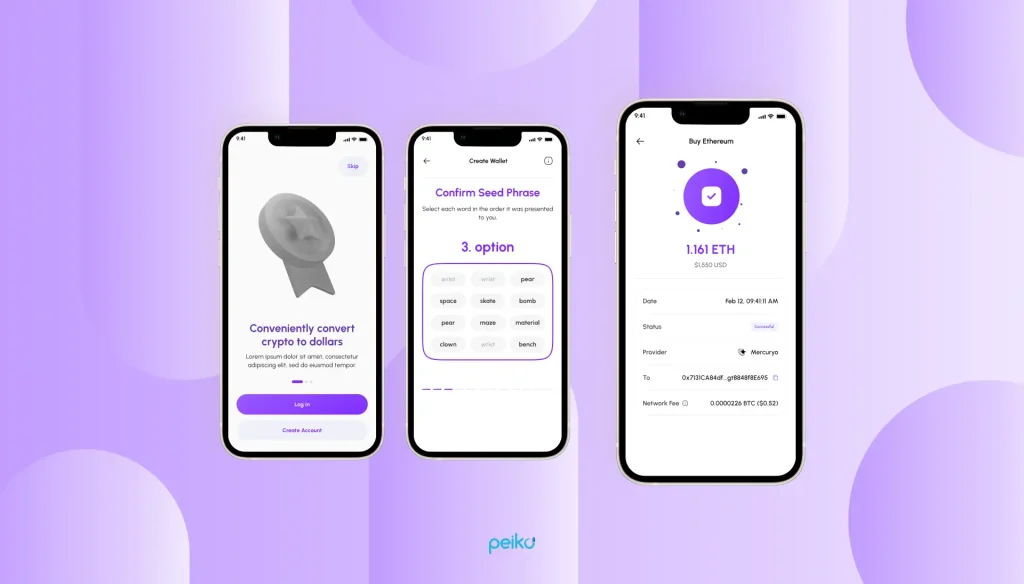
Recognizing the growing trend of mobile-based transactions, the Peiko crypto design agency prioritized a mobile app design first approach. This meant crafting an interface that was not only visually appealing but also intuitive and convenient to navigate on a smartphone screen.
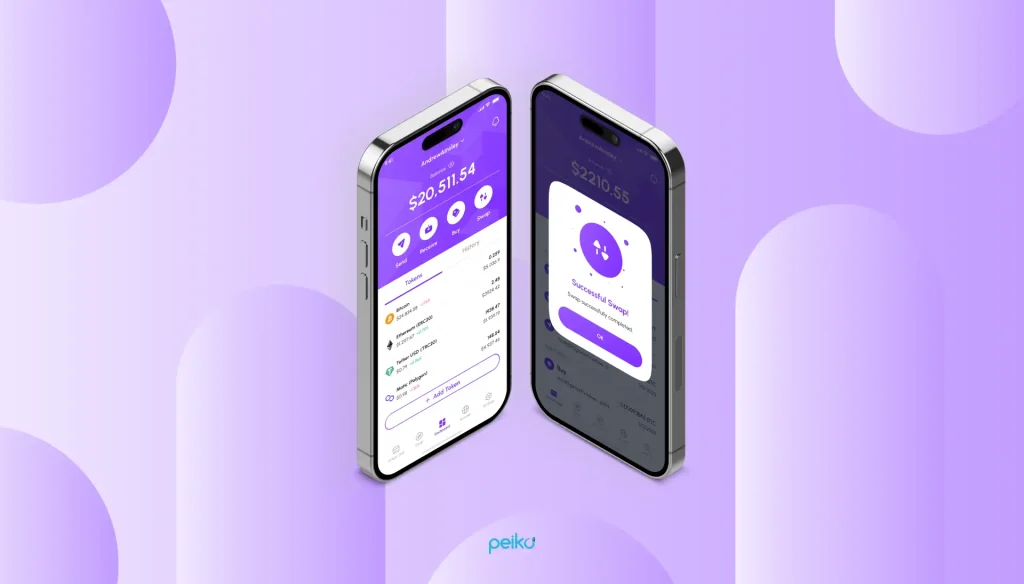
Peiko’s crypto design agency found a crucial balance between modern aesthetics and clear functionality. The app boasts a visually modern design language yet maintains a user-friendly layout with intuitive features. This ensures a seamless user experience for both seasoned crypto enthusiasts and newcomers alike.
At Peiko, we know how to create standout blockchain projects, keeping an eye on the latest trends like NFT ticketing, IoT integration with blockchain, and others.
Conclusion: create outstanding UX/UI
Web3’s future hinges on user experience, not just hype. While the tech is undeniably exciting, companies building the blockchain project can’t afford to neglect UI/UX and broader education initiatives. The key to mass adoption is engaging users, not just having a solid tech side. There are many blockchain solutions on the market, but a considerable part of them are challenging to use and have mediocre and sometimes very complex interfaces.
Professional UX/UI designers prioritize user-centric design and bridge the knowledge gap to make crypto genuinely inclusive. Need an outstanding design for your crypto solution operating on public or private blockchain? Peiko is a trusted cryptocurrency software design services provider with a vast portfolio of successful projects that include great blockchain, mobile, and web case studies like Stark.
Just contact us to discuss your vision and make your product user-friendly today!
No comments yet. Be the first to comment!








